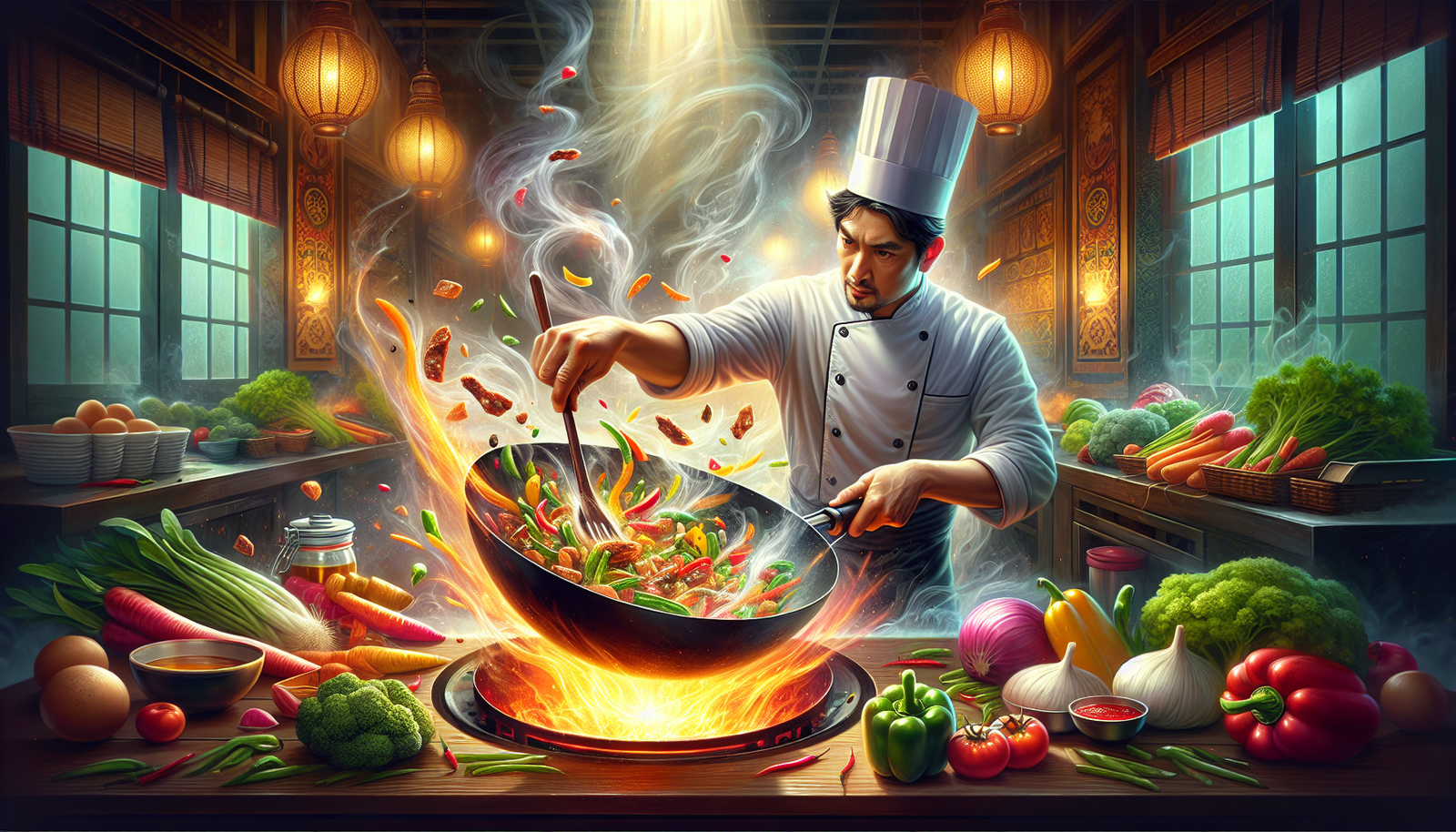
The Importance of High Heat in Stir-Frying: Tips for Success
High heat for stir-frying is essential to achieve those perfect, crisp vegetables and tender meats that define this cooking technique. A staggering 80% of stir-fried dishes fail to deliver authentic flavors due to inadequate heat. This post explores the critical role of high heat in stir-frying and offers valuable tips for success. By understanding the science behind this technique and adopting proper methods, you can transform your home-cooked stir-fries into restaurant-quality dishes. Discover how precise control over heat can elevate your cooking skills and ensure your stir-fry retains the vibrant flavors and textures that make it a favorite globally.
“`html
Why High Heat is Essential for Perfect Stir-Frying
High heat is the backbone of stir-frying, a technique that brings out the best in flavors, textures, and colors. It transforms simple ingredients into vibrant, mouthwatering dishes. Understanding the role of high heat can elevate your stir-frying skills and create culinary masterpieces.
Achieving the Ideal Texture and Flavor with High Heat
The magic of stir-frying lies in its ability to quickly sear food, creating a delightful contrast between browned exteriors and tender insides. High heat is crucial for this effect, as it locks in juices and flavors, giving dishes their characteristic crispiness. When vegetables like bell peppers or snap peas meet a hot pan, they char lightly on the outside while retaining a satisfying crunch.
Meats, on the other hand, develop a succulent flavor profile when exposed to high heat. Proteins such as chicken, beef, or shrimp benefit from a quick sear that keeps them juicy and flavorful. This method not only enhances the taste but also boosts the visual appeal of your dish, making it a feast for both the eyes and the palate.
Retaining Nutrients and Color in Stir-Fried Dishes
Cooking at high temperatures for short periods helps preserve the nutritional content of your ingredients. Vegetables retain more vitamins and minerals compared to prolonged cooking methods. The vibrant colors of greens, reds, and yellows remain intact, indicating freshness and nutritional value.
With high heat, the cooking process is swift, minimizing nutrient loss. Stir-frying is particularly beneficial for preserving vitamin C and other heat-sensitive nutrients, ensuring your meals are as healthy as they are delicious.
Preventing Ingredients from Sticking and Ensuring Quick Cooking
A well-heated pan creates a non-stick effect, reducing the likelihood of food sticking and breaking apart. This is essential for maintaining the integrity of delicate ingredients like tofu or fish. High heat also speeds up cooking, allowing you to prepare meals in minutes without sacrificing quality.
Adequate temperature ensures that each ingredient cooks evenly, preventing parts of your dish from becoming overcooked or mushy. This results in a harmonious blend of textures and flavors, a hallmark of perfect stir-frying.
Tips for Maintaining High Heat During Stir-Frying
To master stir-frying, maintaining high heat is essential. This ensures that each ingredient cooks perfectly, enhancing flavor and texture. Here are some tips to keep your stir-fry sizzling and delicious.
Choosing the Right Oils for High-Heat Cooking
Not all oils are created equal when it comes to high-heat cooking. Opt for oils with high smoke points, such as peanut, canola, or grapeseed oil. These oils withstand intense heat without breaking down, ensuring a clean, smoke-free cooking experience.
Using oils suited for high temperatures prevents unwanted flavors from developing, keeping your dish fresh and aromatic. It also adds a subtle richness that complements the diverse flavors of your ingredients.
Preheating Your Pan for Optimal Temperature
A crucial step in stir-frying is preheating your pan. A properly heated pan ensures that food cooks quickly and evenly, avoiding sogginess or uneven cooking. Wait until the pan is hot enough to create a slight shimmer on the oil before adding ingredients.
Test your pan’s readiness by adding a small piece of food. If it sizzles immediately, the pan is ready for action. This step is key to achieving that perfect sear and maintaining the high heat required for an excellent stir-fry.
Managing Batch Sizes to Maintain Consistent Heat
Overloading the pan can lower its temperature, resulting in steamed rather than stir-fried food. Cook in small batches to ensure each ingredient has sufficient contact with the hot surface, allowing for even browning and flavor development.
By avoiding overcrowding, you maintain consistent heat throughout the cooking process. This strategy preserves the crisp-tender texture that defines a well-executed stir-fry.
Common Mistakes and How to Avoid Them When Stir-Frying
Even seasoned cooks can stumble into common pitfalls when stir-frying. These mistakes can affect the outcome of your dish, leading to less than stellar results. Awareness of these errors and how to sidestep them can enhance your stir-fry skills.
Avoiding Overcrowding the Pan for Even Cooking
One of the biggest mistakes is adding too many ingredients at once, which reduces the pan’s temperature. This leads to steaming rather than frying, causing a loss of texture and flavor. Stick to smaller batches to ensure each piece cooks perfectly.
Proper spacing allows heat to circulate evenly, achieving that desired crisp and caramelized finish. This approach delivers a dish rich in flavor and visual appeal.
Recognizing the Signs of Underheating your Cookware
Underheated cookware is a common oversight that compromises the quality of your stir-fry. If food doesn’t sizzle immediately upon contact, your pan isn’t hot enough. This results in a less flavorful dish with unevenly cooked ingredients.
Ensure your pan reaches the right temperature by preheating adequately. Listening for that initial sizzle can guide you in determining when the pan is ready for cooking.
Timing Ingredient Addition for Maximum Heat Efficiency
Adding ingredients in the wrong sequence can disrupt the cooking process. Begin with those requiring more time, like denser vegetables or proteins, and follow with quicker-cooking items. This strategy maintains heat levels and ensures all components are cooked to perfection.
Effective timing enhances the texture and taste of your dish, making each bite a delightful experience. With practice, this becomes second nature, transforming your stir-frying prowess.
“`
Conclusion
Stir-frying requires cooking food quickly at high heat, usually between 350°F and 400°F (175°C to 205°C). This technique preserves the texture and flavor of ingredients while cooking them evenly. High heat allows for rapid sealing of juices, resulting in a crispy exterior and tender interior. It is essential to continuously stir and toss ingredients to prevent them from sticking or burning. Proper preparation, including cutting ingredients uniformly and pre-heating the wok or pan, ensures optimal results.
“`html
FAQ
What is the best oil to use for high heat stir-frying?
Oils with high smoke points like canola, peanut, or grapeseed are ideal. They withstand high temperatures without burning, preserving the food’s natural flavors.
How does high heat affect the texture of vegetables during stir-frying?
High heat quickly seals moisture in vegetables, keeping them crisp and vibrant. This retains nutrients and enhances the overall dish texture.
Why is high heat important for achieving the authentic stir-fry flavor?
High heat enables the Maillard reaction, creating rich, savory flavors. It also adds a subtle smokiness that defines authentic stir-fries.
Can I use a non-stick pan for high heat stir-frying?
Non-stick pans are not recommended for high heat. They can release harmful fumes and don’t achieve the necessary heat for proper stir-frying. Opt for carbon steel or cast iron instead.
How do I prevent food from sticking during high heat stir-frying?
Preheat the pan before adding oil and ingredients. Use a small amount of oil and toss food frequently, ensuring even cooking and preventing sticking.
What are the best proteins to cook at high heat for stir-frying?
Proteins like chicken, beef, shrimp, and tofu cook well at high heat. They sear quickly, locking in juices and flavors for a tender, delicious result.
“`











